Effort—what MacArthur Genius Grant winner Angela Duckworth famously dubbed “grit”—is essential to success.
However, what unlocks potential is not so much brute force, but a wide-eyed recognition of (1) where we are, and (2) a vision for where we want to be.
In business, this process for unlocking potential and creating an action plan is known as gap analysis.
This article walks through a simplified process for conducting just such an analysis, along with a gap analysis template to guide your future research.
What is a gap analysis?
A gap analysis is a method for identifying gaps between the current performance of a business and its desired performance. This analysis can be quantitative or qualitative and often takes place before an initiative to "close" the gaps.
Understanding the gap analysis in research
The gap analysis methodology goes by many names: need assessment, need analysis, or need-gap analysis. Whatever you call it, the core principle remains the same: to identify and then find solutions to the problems holding your business back.
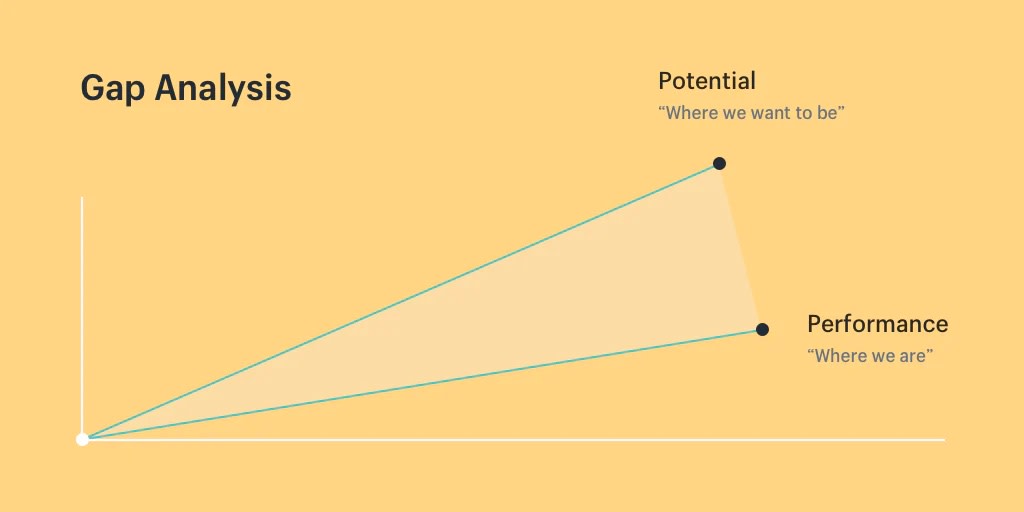
Gap analysis addresses two questions:
- Performance: Where are we?
- Potential: Where do we want to be?
While the process starts with an inward look at current versus potential performance, it doesn’t stop there. Gap analysis should also include outside sources like industry benchmarks and your market’s competitive landscape to determine your desired state.
This type of 360-degree analysis can be performed at both strategic or operational levels. You can analyze your overall business goals or go granular into various processes or departments.
After going through the first phase of analysis—performance versus potential—you may find that your results exceed expectations. The same can also be true if your entire business is currently experiencing fast-paced growth.
In those cases, the aim changes from finding problems to identifying success factors that can be repeated, applied to other areas of your business, and ultimately scaled.
Regardless of what you’re evaluating—be it problems or successes, human resources or logistical functions—the actual process of doing the analysis is the same.
Types of research gaps
In research, gaps can emerge in various forms, such as:
- Knowledge gaps:这些refer to missing or incomplete information in the existing body of knowledge. You can address these gaps by conducting new studies or synthesizing existing findings.
- Methodological gaps:这些arise when existing research methods are insufficient or not applicable to a specific problem. You can address these gaps by developing new research methods or adapting existing ones.
- Practical gaps:这些occur when research findings are not translated into practice or policy. You can address these gaps by engaging with stakeholders and translating research into actionable recommendations.
Conducting a gap analysis, step by step
The temptation with the gap analysis process is to start by going big. Unfortunately, when you try to tackle too much at once—to make everything better, all at the same time—resources get stretched thin.
Instead, prioritize the areas where either (1) the biggest positive impact exists, or (2) you feel the most pain.
This could be any one of a host of factors:
- Sales numbers
- Customer satisfaction
- Retention rates
- Shipping times
- Marketing returns
- Manufacturing costs
- International expansion
Once you’ve isolated an area big enough to make an impact, but small enough to wrap your head and hands around.
1. Identify your states
Once you have chosen your areas of focus, your first step is to identify both where you currently are—performance—and where you want to be in the future—potential.
For illustrative purposes, let’s select:
- Multichannel salesas yourfocus
- Specific outlets as thechannel
- Current monthly sales asperformance
- Industry averages aspotential
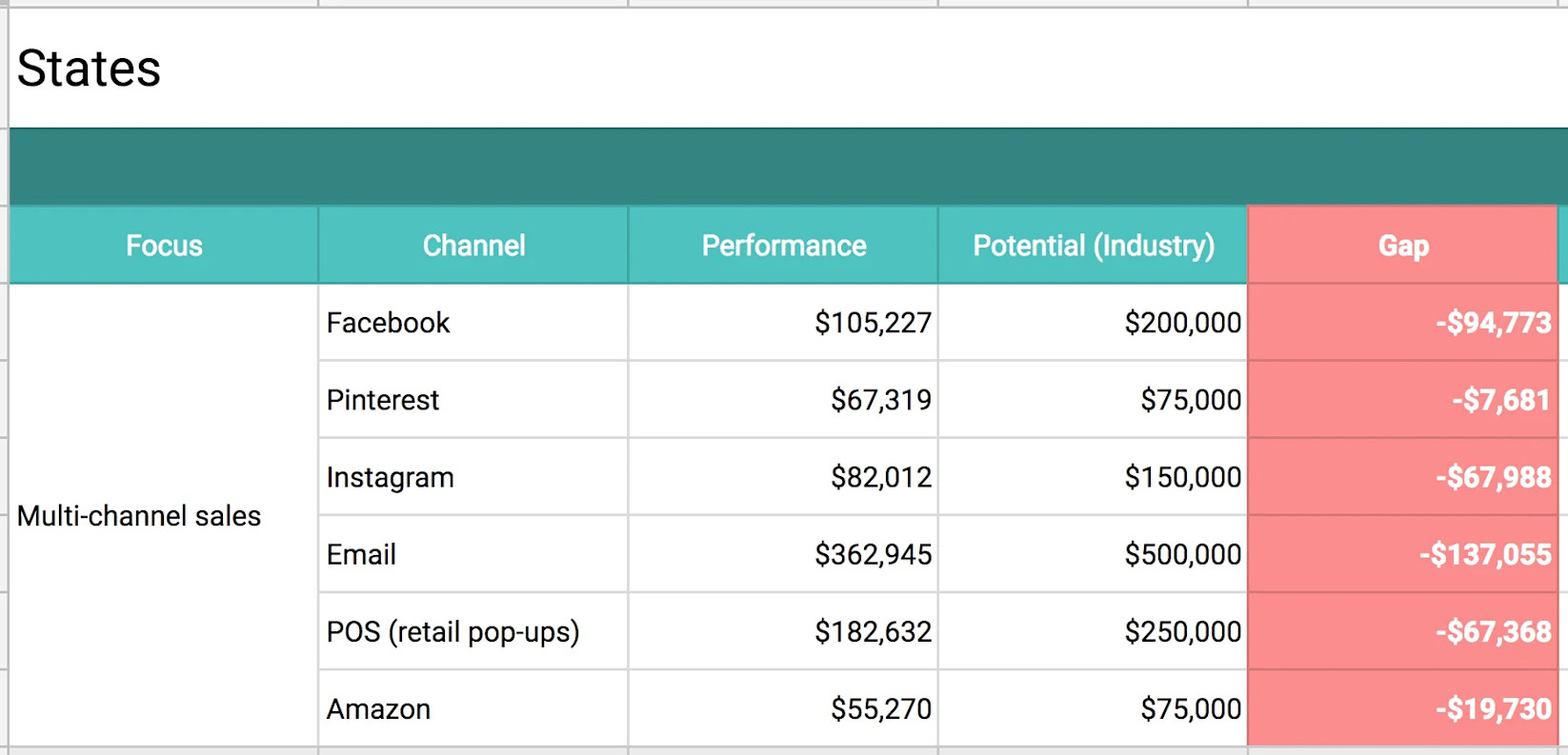
Your current performance
Every gap analysis starts with introspection. Where are you currently within the key performance indicator (KPI) that you’re analyzing? The idea is to list all the attributes—in this case, channels—that play a role in success or failure.
The attributes (and thus the analysis) can be quantitative or qualitative. The key is to be specific and factual when identifying possible weaknesses. The required data can be collected from a variety of sources, depending on what gap is being analyzed, including:
- Industry averages
- Historical benchmarks
- Internal documentation
- Customer interviews
Your potential state
The future state represents the ideal condition in which you want your business to be. For quantitative analysis, like tracking sales metrics, you would include either data from the industry or projected sales (i.e., goals).
When planning for the future, you want to be highly specific by choosing goals within a specific time period (e.g., increase sales by 40% overall by the end of Q3).
Your gaps
Defined quantitatively, gaps are straightforward. What are the numerical differences between where you are and where you want to be?
Qualitatively, this will take a bit more introspection and collaboration.
2. Describe the gaps
Having identified the gaps, the next step is to describe each gap to better understand the reasons behind their existence.
If you’re currently ahead of your targets, then it’s a great time to analyze what exactly made the results possible and if there are ways to use the same principles in other areas of your company.
Even a well-performing system can always be optimized, so going through this step is crucial.
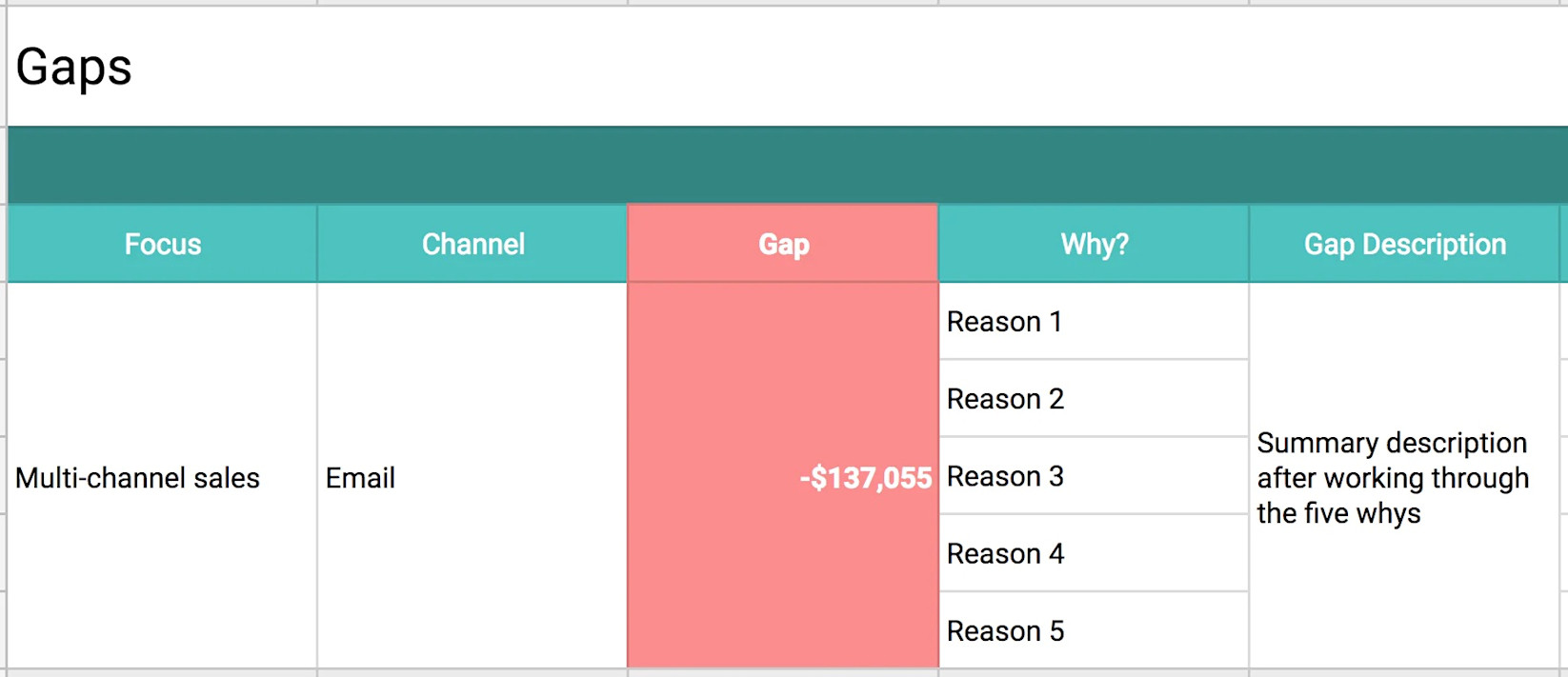
- Gap.This one is easy. Simply carry over the gaps you identified in the previous step, starting with the most underperforming areas first. In our example, we’ve chosen email, because that’s where the widest gap between performance and potential exists.
- Description.The point of a gap description is to record all the contributing factors responsible for the gap. Therefore, the description has to be consistent with those states. These can either be quantitative or qualitative. However, more often than not, to address the reasons behind the gaps, you’ll use qualitative descriptions.
- Why?The challenging question here is not how far your actual performance fell below target, but why the gap exists. To be of any use, this list has to be specific, objective, and relevant to the issue at hand. It helps to brainstorm possible causes of poor performance, and then narrow those down using tools like the “five whys” analysis.
3. Bridge the gaps
The third and final step in your gap analysis report is to brainstorm all the possible solutions to the gaps and the reasons behind them. These solutions must be specific and directly impact the factors listed in the previous step.
To do that, let’s return to the multichannel focus from before:
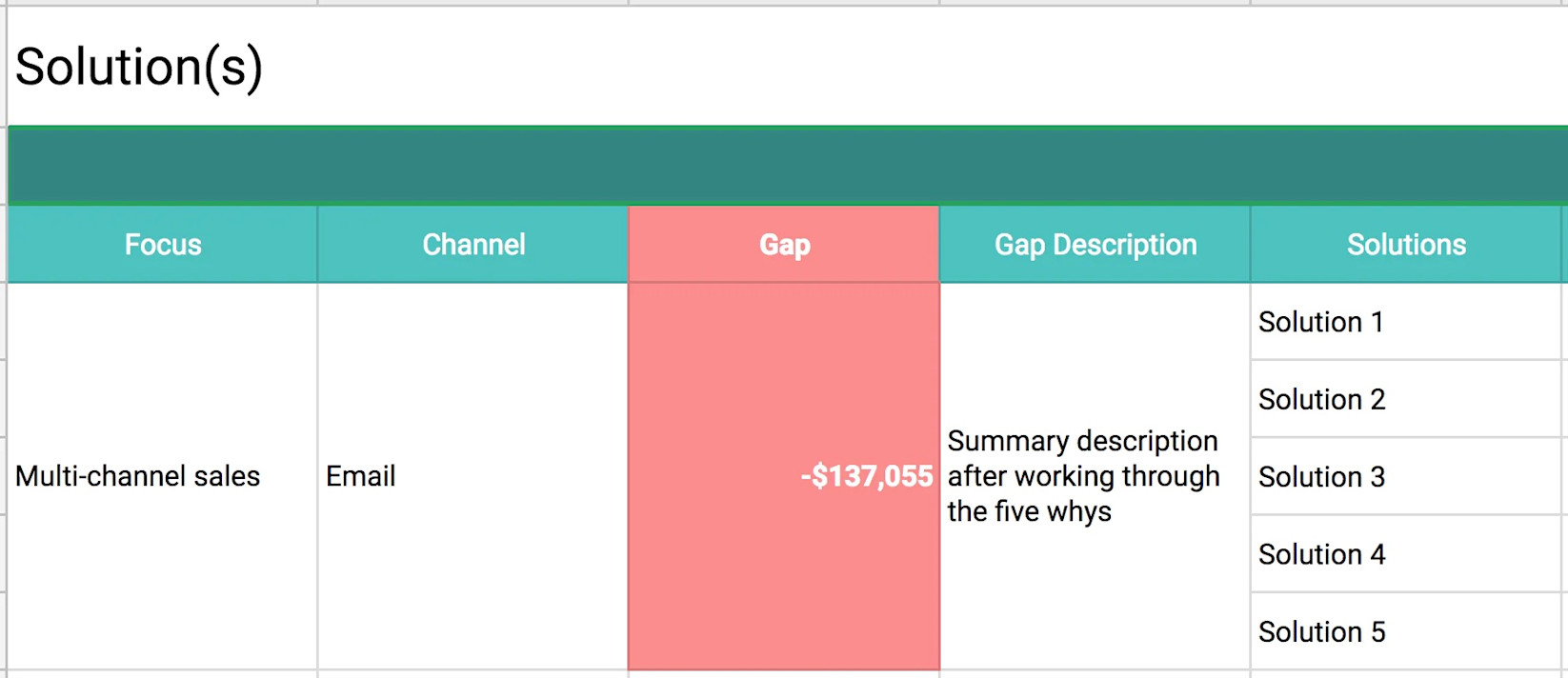
By creating an exhaustive list of solutions to the gap-description summary, you enable yourself to think wide and yet position yourself for practical implementation.
When formulating possible solutions, it’s important to keep in mind that there may be implementation costs involved. Those costs can include time, money, and human resources.
Examples of gap analysis
Ecommerce
The “five whys” is an iterative technique used to explore the cause-and-effect relationships underlying a particular problem. Its primary goal is to determine the root cause of a problem by repeating the question “Why?” with each question forming the basis for the next question.
Although this technique is called the five whys, it doesn’t mean you have to ask “Why?” five times. The idea is to repeat the process for as long as it takes to identify the root cause(s). It can take fewer or more than five whys before you arrive at the underlying issue.
Rather than go the multichannel ecommerce route, let’s look at a situation where customers are unhappy because they’re being shipped products that don’t meet their expectations.1. Why are customers being shipped bad products?
Because manufacturing built the products with materials different from what the customer expected, based on advertising.
2. Why did manufacturing build the products with different materials than advertised?
Because the supply-chain manager expedites work on the shop floor by calling the head of manufacturing directly to begin production. An error occurred when the specifications were being communicated.
3. Why does the supply-chain manager call the head of manufacturing directly to start work instead of using written communication?
Because the “start work” form requires the supply-chain manager’s direct approval before work can begin.
4. Why does the form require approval from the supply-chain manager?
Because the manufacturer does not offer a digital integration with your company’s current ecommerce platform.
In this case, only four whys were required to find out that a non-value-added signature—driven by a lack of integration—caused the gap.
Industry analysis
In industry-focused research, gap analysis often involves analyzing market trends, customer needs, and competitor offerings.
By understanding the unmet needs and opportunities within the industry, researchers can develop innovative solutions and strategies to bridge these gaps and create a competitive advantage.
Profit gap analysis
Ecommerce brands can use profit gap analysis to identify areas where they are underperforming financially.
目标利润是基于历史决定的performance or industry benchmarks. Profits are then compared to targets, and areas for improvement are identified in revenue generation or cost cutting. Ecommerce brands use this analysis to make strategic decisions and improve their profitability.
Gap analysis tools and techniques
Several tools and techniques can be employed to facilitate gap analysis in research, such as:
SWOT analysis
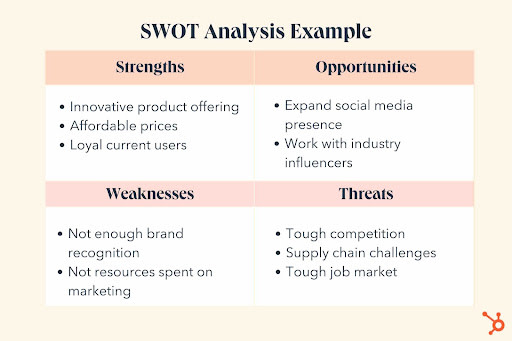
Source:Hubspot
SWOT analysis is a strategic planning tool that helps identify an organization’s strengths, weaknesses, opportunities, and threats.
By categorizing internal and external factors, it helps decision-makers plan and strategize better. The tool is used for setting goals, analyzing markets, and assessing competition.
Fish bone diagram
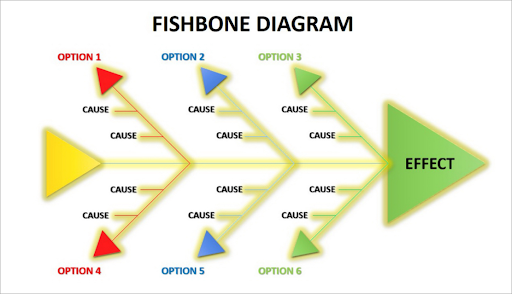
Source:Unichrone
A fish bone diagram, also known as an Ishikawa diagram or cause-and-effect diagram, is a visual tool for identifying and analyzing root causes.
It helps teams systematically explore contributing factors by categorizing potential causes into categories and displaying them as a “fish bone” structure. A lot of companies use this kind of diagram for quality management, process improvement, and problem-solving.
McKinsey 7S
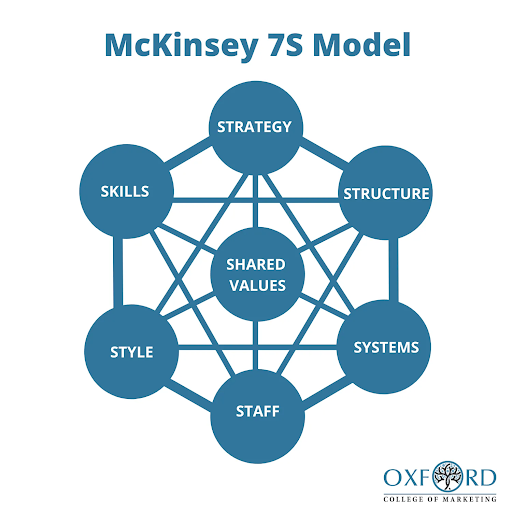
Source:Oxford College of Marketing
The McKinsey 7S framework measures how well an organization’s strategy, structure, systems, shared values, skills, and style align.
这些seven elements are interconnected to identify areas for improvement or change. This framework is used for organizational changes, mergers and acquisitions, or diagnosing and fixing performance problems.
Nadler-Tushman model

Source:Mind Tools
也被称为一致性模型,Nadler-Tushman model evaluates the fit between an organization’s work, people, structure, and culture.
The tool analyzes the congruence between each of the four components to identify gaps, misalignments, and areas for improvement. The model is used to analyze organizational performance, guide change initiatives, and design new structures and processes.
Benefits of gap analysis in research
Gap analysis in research offers several benefits, including:
- Enhanced research relevance:By focusing on addressing gaps, you can ensure your work is more relevant and valuable to your business.
- Improved research design:Gap analysis helps refine your research questions and objectives, leading to more targeted and effective research designs.
- Increased research impact:Addressing performance gaps can lead to more significant outcomes and a greater potential for real-world impact.
- Informed decision-making:Gap analysis provides you with insights to make more informed decisions about research priorities and resource allocation.
Challenges and limitations
Despite its benefits, gap analysis in research also presents some challenges and limitations:
- Incomplete or biased literature:Gaps identified through literature reviews may be influenced by the availability and quality of existing literature, which can sometimes be incomplete or biased.
- Dynamic nature of knowledge:As new research is continually being conducted, gaps may quickly become outdated or irrelevant.
- Resource constraints:Addressing all identified gaps may not be feasible due to time, funding, or expertise constraints.
Best practices for effective gap analysis
To conduct effective gap analysis in research, consider these best practices:
- Maintain a systematic approach:Use a structured and transparent process for reviewing literature and identifying gaps to ensure the reliability and validity of your findings.
- Stay current with research developments:Regularly update your knowledge of the research landscape to account for new findings and emerging trends.
- Collaborate with stakeholders:Engage with relevant stakeholders, such as industry experts, policymakers, and practitioners, to gain insights into practical gaps and real-world needs.
- Balance ambition with feasibility:While it’s essential to aim for impactful research, ensure that your research objectives are achievable within your resource constraints.
Improve your strategic planning with a gap analysis
In the end, gap analysis yields a detailed examination of:
- The problems that exist in your current performance
- The reasons behind those problems
- The possible solutions and their associated costs
Instead of brute force—or “shooting from the hip”—you’ll have hard data on which to base your new products and initiatives, along with a roadmap to guide you.
Gap Analysis FAQ
What is a gap analysis example?
A gap analysis example is an assessment of the current state of an organization compared to its desired future state. This is often done to identify areas in need of improvement or areas where additional resources are needed. For example, an organization may conduct a gap analysis to identify and assess any discrepancies between its current customer service strategies, policies, and procedures and what is required to meet customer expectations. From there, the organization can create specific action plans for improving customer service and ensure that customer service goals are met.
What are the three 3 fundamental components of a gap analysis?
- 识别和理解当前状态:这个involves understanding your current capabilities, processes, and performance in order to identify areas of improvement.
- Setting objectives and goals: Setting objectives and goals for improvement allows you to measure the gap between your current and desired state.
- Implementing a plan of action: Once you have identified and understood your current state and have set objectives and goals, you need to develop a plan of action to bridge the gap between the two. This plan should include strategies and solutions to address any gaps identified.
What are the steps in a gap analysis?
- Identify the current state: Assess the current processes, systems, products, services, and strategies.
- Establish the desired state: Define the objectives and desired outcomes.
- Identify the gap: Compare the current state with the desired state and identify any gaps between the two.
- Analyze the gap: Identify the root causes of the gaps and assess the impact of those gaps on the organization.
- Create a plan: Develop an action plan to bridge the gap and achieve the desired outcome.
- Implement the plan: Put the plan into action and monitor progress.
- Evaluate the results: Measure the results of the gap analysis and adjust the plan as needed.
Is a SWOT analysis a gap analysis?
No, a SWOT analysis and a gap analysis are two different methods. A SWOT analysis is used to identify strengths, weaknesses, opportunities, and threats in a given situation. A gap analysis is used to compare an organization's current performance with its desired performance to identify any gaps between them.






